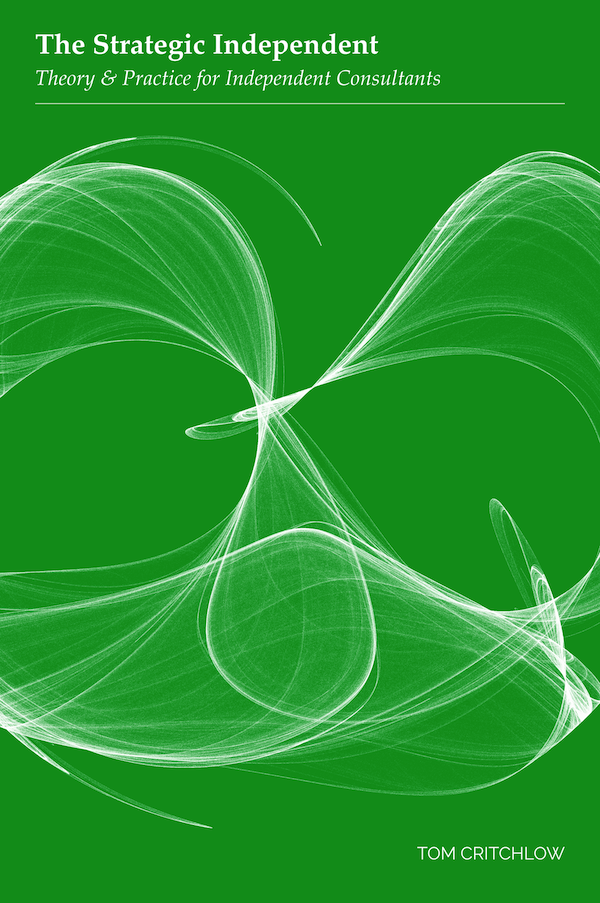The Jigsaw of Independence
Putting together an independent life without falling apart
As I write this I’m feeling stretched thin - my background anxiety is elevated and my brain feels slightly scrambled. I only have a modest amount of client work right now but I’m juggling three distinct types of work: consulting, a new venture1 and writing this book.
These three activities are very different - not only are they different types of work, but they have different incentive structures (client revenue, self directed revenue and personal project) and different tempos. Trying to balance different types of projects that each have varying tempos and incentives is exceptionally challenging and choosing tradeoffs between them is emotionally taxing. How much consulting money am I willing to give up to be completely focused on writing for a day? This is not a theoretical or a simple question.
Unfortunately independent living is full of these emotionally taxing tradeoffs:
- Am I willing to turn down this client project in order to take a vacation?
- Can I really turn down this client project to work on my side project?
- After no clients for two months suddenly I’ve got three clients all kicking off next week!
- How do I find uninterrupted time for deep work when managing this client project means I have to be on-call?
The way to understand these questions is to better understand the shape of our headspace, to better understand the shape of independent work and to understand our personal energy flows.
This requires some introspection and as we saw in part 1: The Consultant Out of Time it requires questioning the underlying assumptions of how we think about time. It turns out that once you give up the 9-5 you literally give up the clock and have to rebuild a time schedule that works for you from first principles.
Hopefully this allows us to navigate independent living without burnout.
First, why headspace is not a “space” at all:
Part 1: Headspace Is a Non-Euclidean Space

Our metaphors matter and “headspace” is a particularly bad one, because headspace is not a “space” that fills up — or rather if it is a space it fills up in some strange ways. In mathematics there’s the notion of Euclidean space which is another name for regular space (forward, backwards, parallel lines never cross - that kind of thing). In Euclidean space, space is uniform and regular. Every 2x2 box is the same size.
Non-Euclidean spaces however are strange spaces with their own rules - in some non-Euclidean spaces it’s impossible to have parallel lines. Space can be irregular - a 2x2 box might be bigger or smaller depending on where it is. And it turns out headspace is more like a non-Euclidean space - with strange properties.
It’s impossible to segment your headspace into neat boxes. Sometimes small tasks consume large amounts of headspace. Sometimes two kinds of projects can’t exist side by side. These properties mean that understanding your own headspace is a tricky concept.
If we think about headspace being a regular space then we might think that we can simply measure how full we are by measuring the amount of work we have committed to: “how many hours am I billing this week? How full is my workload?”. Meaning, we tend to like to categorize our headspace into neat boxes and definitions.
But this model maps very poorly to the lived experience of your actual headspace and stress. Instead we need a more nuanced perspective that accounts for a variety of factors. Determining which factors influence your headspace requires a little introspection and self-analysis, but here’s some of the things I’ve identified in my own work:
Things that increase stress:
- A new client takes significantly more headspace, time and energy than an ongoing client.
- Every new client adds incremental stress, independent of the amount of work for them (and this might be exponential! 4 clients is manageable, 5 is very busy and 6 is crazy)
- A change in point of contact with a long-term client can be as stressful as a new client.
- Not understanding the client’s org chart can consume additional cycles trying to second-guess the organizations behavior and reaction to your work
- A client that uses a non-familiar communication channel (e.g. Teams if you’re used to Slack, or Outlook if you’re used to Gmail etc)
- Clients with the same schedule (e.g. regular Monday morning meeting) can cause a lot of tension where you are forced into repeated time collisions
Things that decrease stress:
- If multiple clients are very similar, that can reduce stress - whether it’s similar type of work or similar working style.
- A familiar working relationship reduces headspace because it makes client interactions more predictable and understandable
- Long term clients tend to consume far less headspace than new ones
- A clear understanding of work that needs to be done
- A clear understanding of the client’s org chart
Some Examples
Let’s look at some real examples from my work. Here’s October 2018 vs. January 2020 where each color is a different client and size is dollar amount.
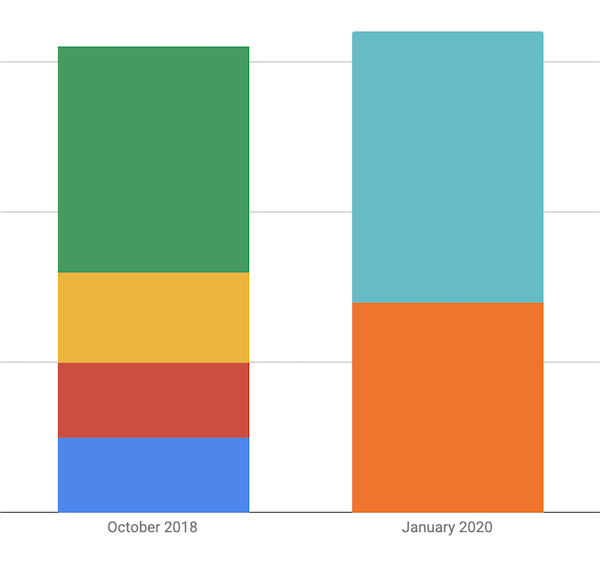
Which month felt more stressful?
If you simply look at total billing then Oct 2018 is slightly less than Jan 2020. But anyone who’s operated as a freelancer or consultant will obviously recognize that two clients is far less stressful than 4, even if those two clients are larger.
If we want a quick and easy method of analyzing headspace you can look at the major factors which are:
- The number of clients (more clients = more stress, independent of size)
- Is the client new? (new clients = more stress)
- How many distinct types of work are there? (more distinct types of work = more stress)
These major factors help explain most of the variance in headspace, but it’s not the full picture. Let’s take a look at this period:
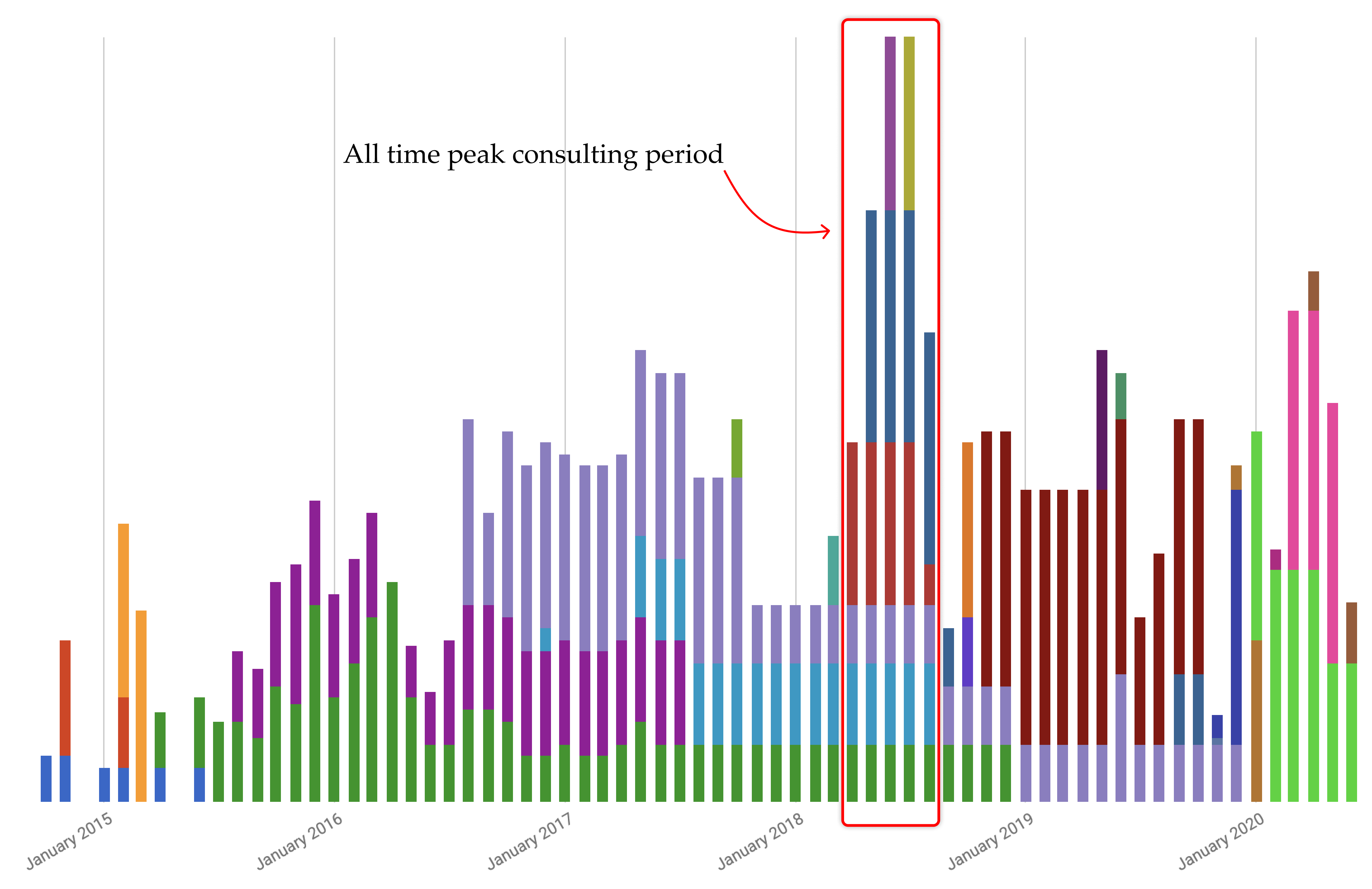
During the summer of 2018 I had the highest billing months for my consulting business — six clients at once for two consecutive months! This period definitely felt like I was “full,” but I wasn’t over the breaking point. Why? Because if you look closely, there’s some nuance:
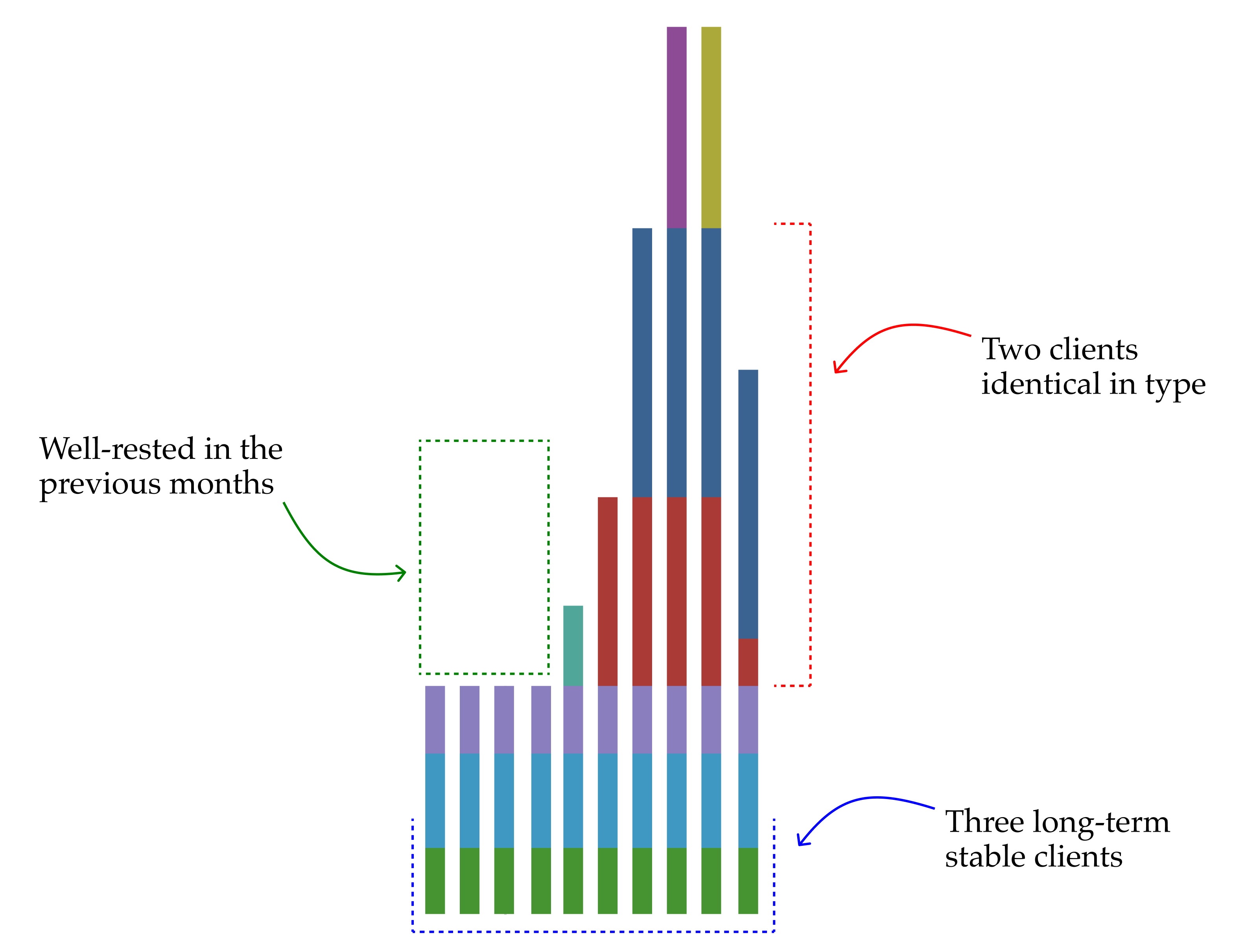
Three key factors led to being able to cope during this period without burnout:
- Three clients (the bottom three in the diagram) were long-term clients — all at least 10 months+. This leads to an ability to quickly context switch into and out of that work.
- Two big clients (middle red/blue in the diagram) were for exactly the same kind of work — audience development work for two media companies. This leads to a lot of redundancy and efficiency in headspace, this was a lot of solving one problem and applying it twice.
- I was well-rested from a quiet period in the previous four-months.
This kind of mental accounting is useful as an exercise in self-reflection, to better understand your own mental headspace and how it relates to what your total capacity might be.
We looked at the major factors that influence headspace above, but let’s look at some other factors (mostly ones that are harder to quantify):
| Increase stress if… | Decrease stress if… | |
|---|---|---|
| Client communication style | Unpredictable or unfamiliar | Predictable and familiar |
| Communication rhythm | Unpredictable or varied tempo / ad-hoc meetings | Predictable, scheduled communication and meetings |
| Understanding of the client’s org chart | You don’t understand or don’t have access to the client’s org chart | You understand the flows of power and status in the org chart and the shadow org chart |
| Client point of contact | Change in client point of contact | Familiar, comfortable working relationship with the point of contact |
| Understanding of the client organization’s goals | Unclear or changing | Clear and stable |
| Understanding of the client point of contact personal goals | Unclear or changing | Clear and stable |
I’m sure you can adjust and add to this table based on your own experience and personal style too.
There’s one aspect of headspace that I want to call out specifically though because it’s so dependent on your individual style - client availability.
Headspace Is a Function of Client Availability
Every client comes with very different expectations and demands for your availability. Not just the time commitment, but what is the expected response time? When a client email lands in your inbox how quickly do you feel you need to respond?
This is a critical question because it’s going to dictate how much work you can handle at once and your overall stress levels. It’s not just about the client’s communication style and expectations but how compatible your working style is with the client’s.
Some independent consultants are just not comfortable being highly available to clients. And if that’s true then you need to design your offering and consulting work around it otherwise you’re constantly going to be fighting clients who want higher availability!
I’ve written about this before - specifically about how “executive sparring” (work limited to 1:1 sessions with a senior executive) has extremely small time demands outside of the sparring session itself, whereas managing a client project launch might require responding to slack pings from multiple teams in real time throughout the week. In general, “doing” work requires you to be much more available and on-call than “thinking” work - with executive sparring having perhaps the best money/availability ratio. From my notes on Sparring as Tenure:
So is sparring just an intellectually stimulating but less-well-paid version of consulting?
No — there are some clear benefits of chasing sparring as consulting.
Firstly, I’m a decade younger than Venkatesh and still able to pull stunts like billing 3 days a week to one client while also billing 3 days a week to another client. Dipping into energy reserves and sprinting on work for sustained periods throughout the year. Much like physical fitness I can already feel my capacity for this declining.
Secondly, “doing” work captures a larger portion of your head space. When you’re managing a marketing org you can’t “take Thursday and Friday offline to write blog posts”. Operational work requires high availability and an “always-on” mentality. Especially if you’re in doing mode for multiple clients at once. It can be incredibly demanding on your time and any side project / writing / teaching / long-term research gets consistently interrupted, paused or put on hold.
In a nutshell, sparring work is long-term stable, well-paid work relative to the amount of headspace and energy required.
Different kinds of work will have different demands on the availability of your time.
For example, if you’re in the habit of running four-day brand sprint workshops, then you should expect to be deeply immersed for those four days (and likely some days before/after) and almost entirely unavailable for other clients or projects. However, you may well be largely free outside of the workshop — with client demands being minimal.
There’s no right or wrong type of work — but you should closely interrogate your own working styles and recognize how stressed it makes you to be on-call with clients. Personally, I have three client email addresses and three client Slack groups, and I don’t mind having a high availability for each of them. But some consultants I know can’t stand that low-key background stress of being available at any time for clients.
And be mindful of signing clients for small amounts of money that have high availability expectations.
Ok, so now that we have a more nuanced understanding of the shape of our headspace we can start to do things with it.
Part 2: Headspace, Pricing and Downtime
Understanding the shape of headspace is a mostly intellectual exercise so let’s look at some practical applications - and see how headspace and total capacity relate to the shape of independent work (which is most definitely not stable and predictable!).
Pricing in the Pain
One of the best non-obvious pieces of pricing advice I was given is that you should always price projects so that you’re happy if they say yes.
What does this mean? It means pricing in the drag on your headspace - taking into account the factors above and beyond simply the time commitment, but looking further to the headspace commitment.
- Think the client is going to be a nightmare to work with? Charge more.
- The organization’s structure and complexity is opaque to you? Charge more.
- Slammed with work right now and this will be your 5th client? Charge more.
- The work is going to be high-availability? Charge more.
Refer back to the ideas above around what causes a client to take up additional headspace and you’ll find a set of factors that you should consider when pricing up a project.
It’s OK to put yourself at or over your max capacity if you deliberately choose to, but doing it accidentally or doing it with underpriced work is a huge mistake that leads to burnout. Make sure you’re getting paid for sprinting at max capacity.
And speaking of max capacity… what is the shape of independent work? Turns out it’s not at all stable and consistent.
Preparing Yourself for the Peaks
One of the defining features of independent work is the variable nature of clients. How much work you have at any point is variable — how much money you’re earning is variable too.
Because your client load and income are going to fluctuate, it’s important to consider your total base capacity and your burst capacity.
Total base capacity is how much work you can comfortably manage over long periods of time. Understanding this will give you a sense of your baseline income and the sustainability of your consulting model.
Burst capacity is how much work you can handle at a sprint for a limited time (think one to three months) at absolute maximum capacity without burning out.
While it might seem that total base capacity is more important, in reality most indie consultants spend their months at 50-80% base capacity so the number is not that meaningful - what really impacts and dictates their workload and income is their ability to handle burst capacity.
Look again at this chart:
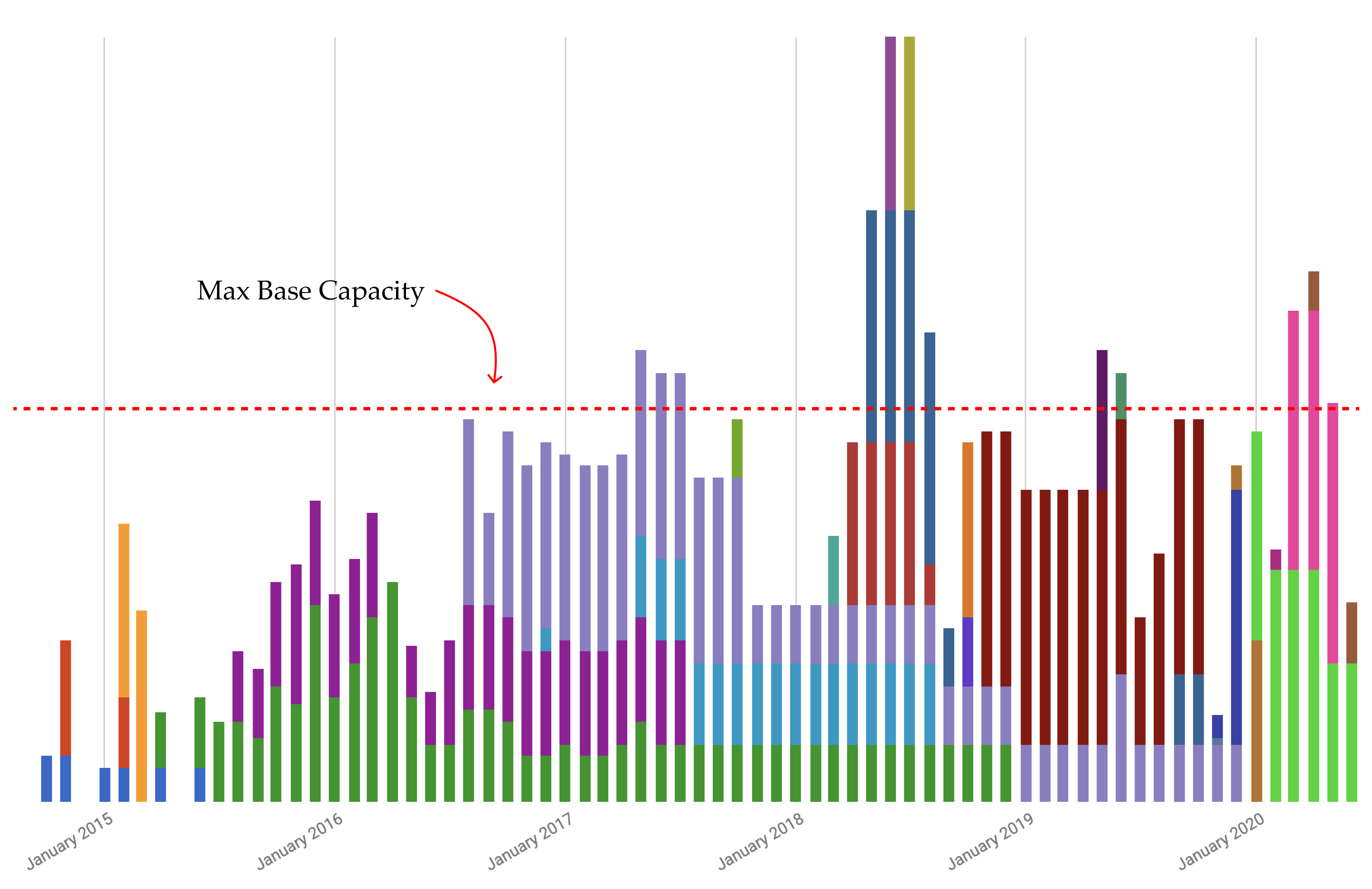
The red dotted line here is roughly equal to my max base capacity. Note how I’ve spent a few periods consistently around this limit but most of my work is 50-80% max base capacity.
Your natural instinct might be to stop accepting work that goes over your max base capacity. After all, what’s the point of having a max capacity if you’re going to ignore it? But if I’d capped my work there I’d have missed out on a significant chunk of revenue.
Adding a ceiling to your client work has a real impact on your revenue - not only do you lose out on in the immediate revenue but almost certainly lose out on the lifetime revenue from that client (most clients aren’t particularly flexible on starting date and if you miss that window you’ll most likely lose the client completely).
For example - if you look at the above image where the red line is drawn, in 2018 I would have had 27% less revenue from being unable to take on those projects.
This is a common feature of variable systems - one study showed that if you’re investing in the stock market and miss the 5 best days a year you lose 35% of your returns!
Independent consulting can feel the same way - highly variable client leads make your revenue highly variable and attempts to “smooth” this revenue are mostly tilting at windmills. Instead you should embrace that your workload (and revenue) is going to fluctuate and prepare best you can for the bursts - increasing your burst capacity (without burnout!) is essential.
So if your ability to handle peaks (without burning out!) is directly related to your earning potential, how do you get better at dealing with peaks?
This requires operating outside of traditional time expectations and rejecting deliverables as we saw in the last chapter. But it also requires learning the skill of efficient context switching.
Learning the Skill of Context Switching
Just like transaction costs are at the heart of economics for firms, context switching costs are at the heart of indie consulting economics. Learning good context switching, and splicing time from one client into another client, is generally good practice and will serve you well — but the skill becomes essential during peak periods.
Context switching is basically the tax you pay for switching between one client and another. People’s initial idea about context switching is you need to be able to build good onramps - ways to “get up to speed quickly” but actually the secret is building good off ramps - ways to save your current position in a task/project/client and freeze it so you can come back to it later.
For Venkatesh - note taking is a key activity for context switching between clients:
Once I started my note-taking, all that changed. Meeting sequences began to feel like steady forward progress with very little backlash. Context-switching between clients got much more pleasant (particularly important on days when you have back-to-back meetings with entirely different clients, which I try to avoid, but sometimes happens).
Clients often don’t recognize the value of the notes initially. Superficially, it seems like make-work. But as the relationship develops, they realize that it’s the core of why sparring with an external consultant is valuable at all. Even if you never refer back to the notes, and your client never does either, the very fact of writing them up lends a smooth continuity to the conversation track, and a sense of accumulating insight and value. It is at the heart of the deliberate practice element in executive sparring.
In my own work I find a few things provide the ability to “save state” and perform rapid context switching:
- Keeping personal notes on every meeting - these are distinct from meeting minutes. Personal notes preserve context about things like emotion and include my own commentary on things I noticed or observations about power and status, unexpected actions etc.
- Writing down a clear north star metric for every engagement that maps to the highest level ambition of the client (the key is to actually write this down, not just try and remember it!)
- Communication by default - so that whatever I’m working on is shared with the client and not a surprise (so we can both get up to speed fast)
- Keeping a mini “client control center” where I meticulously keep handy all of the links to the key documents, project management login URL etc.
Just-in-Time Downtime
If preparing yourself for the peaks is important, it’s just as important to prepare yourself for the troughs. Those slow times can be paralyzing and demoralizing for independent workers.
The best advice I got when I started out consulting (thanks Dave!) was to make the most of your downtime. When you have free time, make sure you use it to recharge and rest. For me this is biking and kung-fu (and blogging!). And it’s important to give yourself permission to take downtime and recharge “on the clock” during the work week.
Taking a bike ride at 11am on a Tuesday might feel like slacking off but it’s actually a crucial part of operating as an independent consultant. Because when 3 clients all sign at once and the work peak arrives there’s no smoothing function and there’s no team to back you up - you just have to buckle up and dive in.
During these peaks you’re likely going to be working long hours, nights and weekends and letting client demands walk all over your personal time. If we’re ok with client work encroaching on our downtime, shouldn’t we be comfortable letting our downtime encroach on our working time?
This isn’t theoretical. If we look again at my all-time peak, the only way I handled it without burning out was the rest and downtime I’d opportunistically taken for myself the previous months:
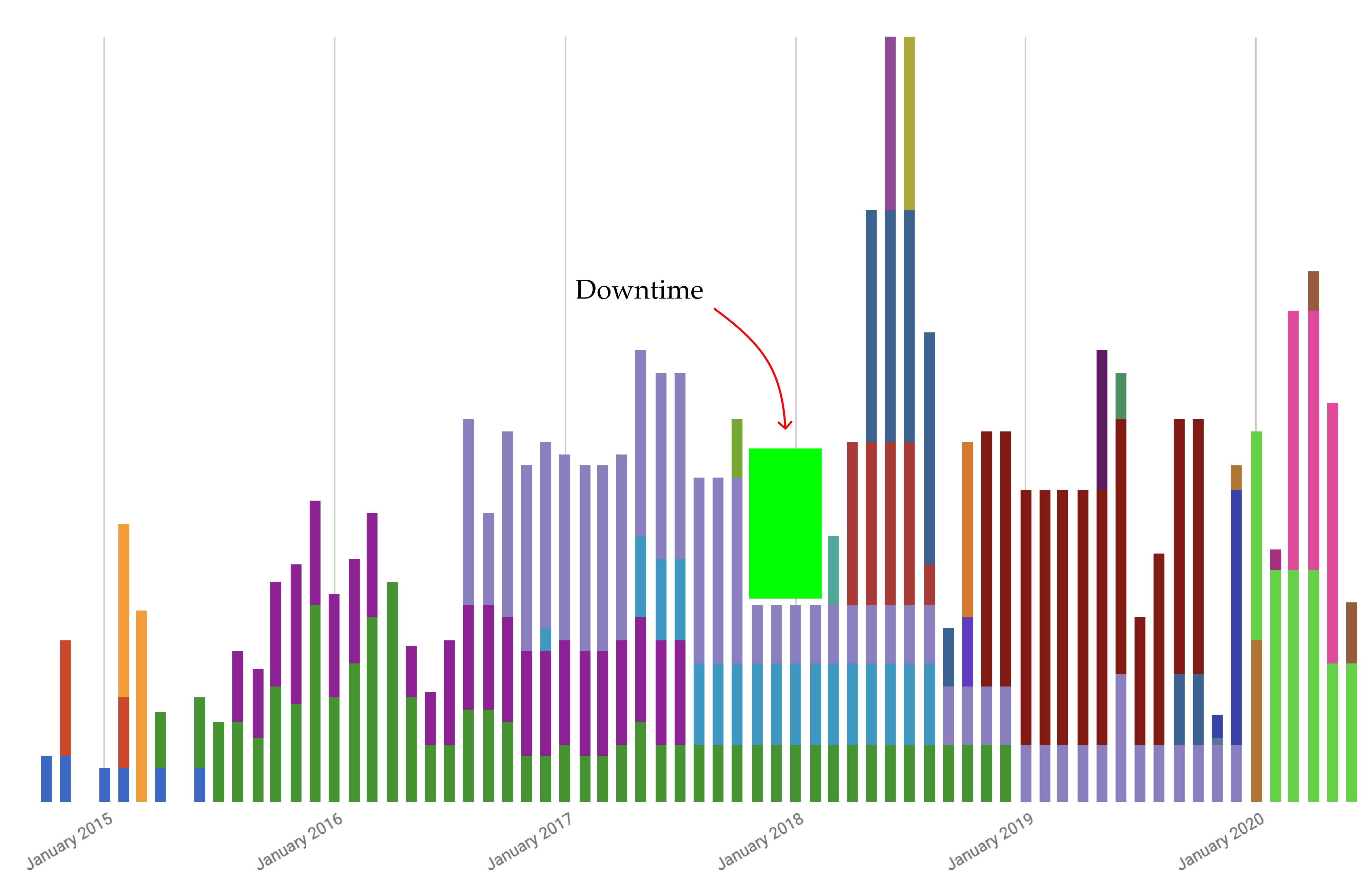
This advice is easier said than done of course - especially when you’re newly starting out. How do you have confidence in your system to be able to take breaks before you’re reliably generating income?
This is a tough chicken/egg problem to crack - my best advice is to surround yourself with other independent workers to be able to observe their behavior. Having a desk at a coworking space full of independents in year 2-3 of my indie journey allowed me to absorb the working styles of independents. It’s all over the place, evenings, weekends, late starts, early starts, weeks without coming into the office. All kinds of behavior - but most crucially everyone takes breaks as needed, not when the breaks are scheduled.
Part 3: The Energy Matrix
OK great, we solved the headspace equation and completed the jigsaw of independence! Yes, well, actually no not quite.
There’s another component — your motivation and your energy. Not only how busy you are but how satisfied you are. This is more complicated. You can be “at capacity” but feeling on top of the world, or you can be only partially full with work and feeling despondent and without motivation.
While working with Sunil, my executive coach a few years back, he opened my eyes to this energy matrix - a diagnostic tool to understand where satisfaction comes from. It’s incredibly simple and adaptable to your needs, but in essence it works like this:
- Identify a set of “things that are important” — these are types of activity that you find important and/or provide you with energy.
- Score every major project with a score (I use -1 to +3 but it’s not an exact science).
- Add up the rows to find out which projects are giving you the most energy.
- Add up the columns to find gaps in your satisfaction.
Here’s a real example from that max capacity period before, when I had six clients at once:

For me, I identified eight core things that provide me value:
- Leading others means aligning teams, providing direction and generally playing a leadership role.
- Learning and being challenged means pushing myself into new situations, learning new things.
- Giving energy means motivating and encouraging others, building others up.
- Face to face means feeling that adrenaline rush of meetings, workshops, and presentations live.
- Creative means having creative outlets — from mocking up landing pages in Figma to outlining a creative strategy in Slides.
- Authoring means publishing writing to the internet.
- Connecting the dots means building my network and making good connections between people.
- $$$ means paying the bills and sustaining my family.
Identifying these is not trivial, but the good news is you can update them easily!
Here’s the above matrix in a spreadsheet for you to copy (but remember to identify your own values!)
It’s crucial here to look at the full spectrum of projects, everything that fits inside your “independent identity” container. Not just the client work but all the side projects, blogging, writing etc. I called this post the “Jigsaw of Independence” because unlike in full time work you get to choose the makeup of projects.
As an independent worker you can assemble a patchwork quilt of client work and personal projects that sum up to a satisfying workload. But this work needs to be intentional and deliberate otherwise you’ll end up at the whims of client work. Instead you need to strategically assemble a patchwork of projects that you can spin up/down just in time, as needed, to scratch your itches and fill up the various buckets.
In fact this is part of the promise of indie consulting - instead of a monolithic single commitment that needs to fulfill all of your needs you can add and subtract commitments to balance, and evolve, your needs as you go. And you can balance revenue generating projects with non revenue generating projects just fine!
This is all part of the never ending process to define your own identity as an indie consultant now that you’re on your own and no one is telling you who you are anymore…
Part 4: Grinding Gears between Chronos & Kairos living
So far the key to a sustainable independent lifestyle is operating outside of traditional time scales - operating on Kairos time, not Chronos time. We do this by embracing just in time work, dealing with burst capacity and grabbing rest with just in time downtime.
Some things don’t change though - we still need the same fundamental things as full time workers: identity, vacations, financial security, satisfying work. The key difference is that for full-time workers you re-evaluate these things infrequently - typically when you move from one role to another.
But indie consultants - kairos workers - are able to re-evaluate these things continually with much more flexibility and iteration. This can be a blessing and a curse as we’ll see…
Always-on career change
Let’s take a look at the difference between a full-time worker and an indie consultant:
| Full-time worker “Discrete step changes” | Indie consultant “Always-on and self-directed” | |
|---|---|---|
| Identity | Defined by your job title — changes when you get a new job. | Self-defined, renewed and pivoted as often as you like. |
| Income & pay raises | Income fixed by job. Pay review cycle is typically yearly. | Monthly/quarterly/yearly — how you track it is up to you and highly variable, depending on client load and billable rates. Income can go up and down! |
| Vacations and time off | A few weeks a year, booked in advance. | Time off can happen when client work gets slow, sometimes on a moment’s notice. |
| Job hunting | When you’re laid off or actively looking for a new job. | Constantly seeking new clients and connections. |
| Job satisfaction | Depends on step changes (new boss, new team, new job). | Always fluctuating, dependent on a mix of clients and projects. |
| Learning & development | Formalized skills ladder, often with conference budget and courses available so long as you stay in your lane. | Self directed learning with plenty of room for experimentation. Everything paid for out of pocket. |
Understanding and embracing this transition — from discrete step changes to an always-on mindset — can be difficult. You have to unlearn ways of operating in your personal and professional life that are deeply ingrained. You need to rewire your personal operating system.
And, further — there’s no boss to rail against except yourself. As Venkatesh wrote in the Art of Gig2:
The problem is, as a free agent, you are your own boss, and you’re likely a bad boss, unable to relax, and driven by fretful anxiety about lining up the next gig. That would be bad enough, except that you’re also an omniscient bad boss. You know all your own tricks, and nothing is hidden from you. You can’t sneak away from yourself.
The key point here is that there’s less stability and less commitment as an indie consultant. Change is always available - which means your personal development is “always on” and will change in many small steps vs big discrete jumps. Just like we should adopt a kairos mindset to consulting work we should adopt a kairos mindset to personal development. At the same time however, because everything happens in increments, there’s very rarely any external validation that “you’ve made it” in the same way that a promotion or new job might provide this sense of achievement.
I was an indie consultant on day 1 when I quit my job with zero clients and income and I’m an indie consultant today almost 7 years in with over a million dollars of income from consulting. The path from one to the other has been a meandering adventure with no clear breaks or jumps…
Let’s illustrate this with an imaginary example. Let’s say I wake up tomorrow and decide I want to do UX design consulting work. I can change my website, update my “hire me” page, change up my creds deck and write a blog post or two about UX design. The same day, I’ve already pivoted my identity. But at the same time all I’ve done is update things directly within my control. The question is how much do I buy my own BS? How much do I feel like a UX designer vs just feeling like a fraud?
The point here is not that one way or the other is better (though, I have some thoughts) but rather there’s a tradeoff in both directions and you need to understand that being indie is fundamentally, structurally different from being a full time worker. Not just because of the freedom, but because of the lack of support, structure and validation.
The inner game of consulting is all about creating mental models for thinking about time, energy and headspace. You need to learn how to understand and manage your own psychology if you’re going to survive.
Grinding Gears between Chronos and Kairos
One danger for independent consultants — trying to match your just-in-time living with chronos workers. I’m lucky enough to live in a kairos household; my partner runs her own business and makes picture books, so we’re not operating on chronos time.
But trying to line up kairos and chronos living can be tough.
Taking time off is a great example of where gears grind. The mental model of work/rest from chronos living doesn’t translate well to kairos time
Here’s a quote from a fellow independent consultant that articulates some of the angst and psychological gear grinding when chronos and kairos meet:
I am constantly hearing people say to me - “you work too much. You need to slow down. Take a break. Shouldn’t you be working less as a consultant? Isn’t that the point?”
I just about worked from Jan straight through summer, - 7 days always on - even in Cannes, even in pretty beachside places.. and phew, summer is always full on as a consultant. And this year, I paid a hefty price of stress on my body and thus am dealing with it. So now am taking 4 weeks off (as best I can which means just one client vs many - I am, me after all) in the fall. The response is, “must be nice. Wow. Who gets to do that?!”
If I change the dialogue to, “I certainly feel I earned some time off”… I get the same response. “Wow, must be nice to not have to work all the time. Consulting must be great business!”
I’ve really struggled with not feeling frustrated with these comments and taking them personally. Taking a set bulk of time off doesn’t mean I work less. Having flexibility to go to things during the day also doesn’t mean I work less than others - it’s a different cadence.
When we work on our own, or own a small business - we get amazing flexibility. But we also don’t have fixed incomes and ‘PTO.” PTO - ha! On your own, you have to use different muscle and motivation to often work doubly hard and smarter. Over the years, I’ve felt that sometimes the guilt of not working, is so intense it’s hard to actually commit to a break… Someone a few weeks ago told me, as solo entrepreneurs - you are always future-minded, and the present can be a challenge sometimes to simply put pencils down and live in it. That resonated with me. Sometimes I think I’m getting better at it. Sometimes it’s two steps back.
But hopefully, finding a way to let go of that judgement I’ve felt when people say - wow must be nice.. and instead just say, YUP IT IS
Amen to this. The independent life is full of new kinds of tradeoffs, and this can cause a lot of friction when Chronos and Kairos meet. We can return to that chart above to better understand where gears can grind:
| Full-time worker “Discrete step changes” | Grinding Gears | Indie consultant “Always-on and self directed” | |
|---|---|---|---|
| Identity | Defined by your job title — changes when you get a new job. | “You’re always launching something!” Hard to keep a stable idea of what you do, launching ideas faster than chronos is comfortable. | Self-defined, renewed and pivoted as often as you like. |
| Income & pay raises | Income fixed by job. Pay review cycle is typically yearly. | Can you pay the bills? Stability? | Monthly/quarterly/yearly — how you track it is up to you and highly variable, depending on client load and billable rates. |
| Vacations and time off | A few weeks a year, booked in advance. | We can’t just go to Hawaii next week! My work needs to know if we can book those two weeks in the summer. | Time off can happen when client work gets slow, sometimes on a moment’s notice. |
| Job hunting | When you’re laid off or actively looking for a new job | How do I describe what you do? You’re always changing how you describe yourself and your work. | Constantly seeking new clients and connections. |
| Job satisfaction | Depends on step changes (new boss, new job). | Highly variable job satisfaction. | Always fluctuating, dependent on evergreen satisfaction. |
| Learning & development | Formalized skills ladder, often with conference budget and courses available so long as you stay in your lane. | Self directed learning with plenty of room for experimentation. Everything paid for out of pocket. |
Part of the problem here is that it’s easy to describe the differences between full time (chronos) work and indie (kairos) work - but you don’t really internalize and understand the differences until you live them. And many of these changes happen to deep rooted concepts like financial stability, identity and our sense of self worth.
Because the indie path removes all sense of validation, credentialing and identity you might have to take some things seriously even if they’re not client work. Assembling and recreating all the pieces of a full-time career is non trivial and requires a patchwork assemblage of projects - the jigsaw of independence.
Conclusion: the only way out is in
The key insight underpinning everything here is that:
- As an independent worker your relationship to time, stress, money and rest all need to re-negotiated. To create a sustainable independent path you need to create new routines, new ways of working and new ways of skiving off.
- Navigating these changes requires a deep introspection and self-analysis to notice how you feel when you’re busy, to notice what kinds of work light you up, to notice how you feel when you’ve got no work.
It’s not that the only way out is through, but rather the only way out is in(side). You need to learn to be self aware in a continual way - to be always keeping track of your stress, motivations, incentives and energy.
Walking the path of an indie consultant you will learn to live an alternative path outside of all kinds of “normal” structures - this can be disorienting and demoralizing but ultimately it puts you in control of your own time, energy and identity in a way that full-time work can’t.
I remember clearly in the early days of consulting — I met someone I respected who managed a ton of different projects at once — it was noon outside Whole Foods. He had his feet up on a bench, sitting in the sunshine and eating some sushi.
I asked him, “How do you do it? You do so much and you’re sitting here eating sushi!” He said, “It’s simple; you can do it too. The sushi is right inside and it’s only $10.”
Your mindset and your energy dictate your capacity far more than actual time — Chronos time. Learn to embrace kairos time and just-in-time living to build a more sustainable independent practice and better understand your own headspace.
-
Venkatesh’s newsletter the Art of Gig has been taken offline while he prepares to turn it into a book. Follow Ribbonfarm Studio for updates. ↩
